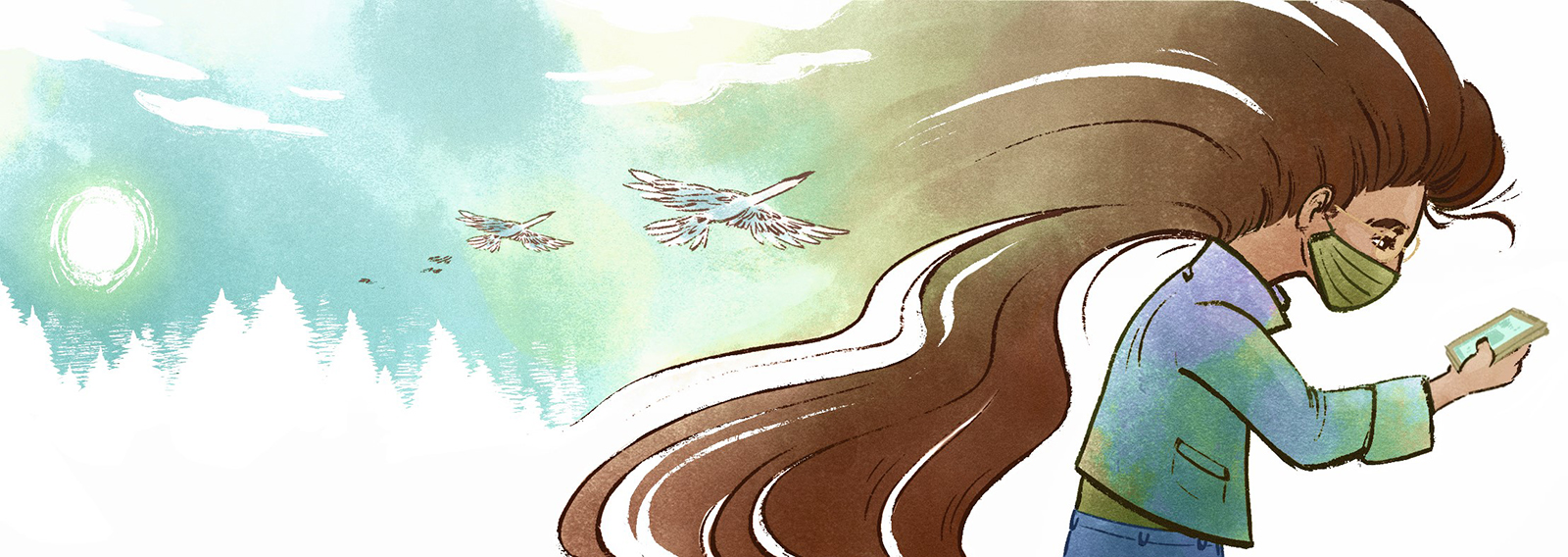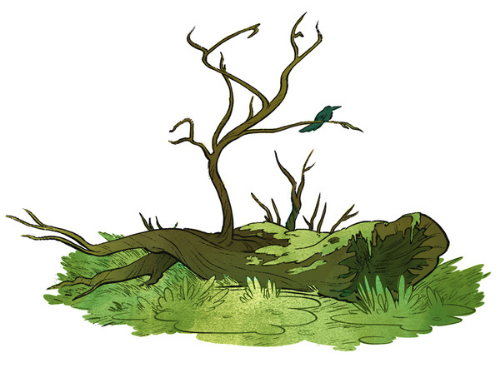

Like most people on TikTok, in 2020 I followed the true-crime story of randonauters finding a dead body, and it piqued my interest in the Randonautica app. In a since deleted TikTok, two teenagers using Randonautica encountered a suspicious smelling suitcase in which they found the human remains of two murder victims.
The Randonautica app first launched in February 2020, becoming a popular fixture on TikTok as users show their destinations. It also boasts an active subreddit of 147,000 members, and millions of YouTube views courtesy videos featuring randonauting adventures and misfortunes, including these favorites that topped 100,000 views — ”RANDONAUTICA IS CREEPY - FOLLOWED BY A CRAZY GROUP OF PEOPLE,” “RANDONAUTING IS TERRIFYING - VERY SCARY EXPERIENCE,” or simply “We Went Randonauting And THIS Happened….”
To launch users into these outdoor adventures, Randonautica uses a random number generator and asks a few questions to select coordinates users can navigate with their phone’s GPS. Users can choose between “anomalies” or “blind spots,” which are simply random points (think of it as geocaching, but with less potential reward). According to the Randonautica website, the main goal is to “research reality outside of the framework created by methodological templates, as well as to search for novelty and reveal the potential of consciousness that creates our surrounding reality.” In other words, the app encourages users to set intentions for their journeys so that the intentions align with a location, possibly proving the power of manifestation and the existence of a multiverse.
I tried to entice them with the possibility of bodies in suitcases and supernatural beings.
Setting an intention is not just a feature of algorithmic adventures. It’s also a common practice in meditation. “Setting intentions during a meditation is impactful because then you are not just thinking about your earthly self,” explains licensed therapist and meditation coach Sheila Applegate. “You’re not thinking from a survival space or the limitations of your daily life. You’re accessing another aspect of yourself where you may be more in tune to what you really want at the core of your being and because of that, you’re in alignment, and when you’re in alignment, the frequency of that intention will attract what you desire.”
On Reddit, randonauters have shared their own pre-adventure intentions, which range anywhere from intangible ideas such as “love” and “memories” to concrete objects such as “dog” or “trees.”
The idea of being able to jump to a dimension that might offer a better reality than this one intrigued me. After living the past year through a computer screen and social isolation, I longed for an experience that delivered something other than the same day on perpetual repeat. So, on a blustery winter day, I jumped in the car eager for an experience that might deliver something extraordinary (or, at the very least, something less ordinary). Outside my windshield, the cascade of falling snow added an aura of mystery to the trip.

But then I noticed the first of several flaws with Randonautica: It limits the radius a user can set from their original location to their next point to a mere 10 kilometers. That seemed a short distance for the big adventure I hoped for. But I continued, setting my intention as “hidden,” hoping to find some hidden treasures or perhaps some abandoned building, and I picked the “anomaly” option. First, Randonautica dropped me off on the side of a suburban neighborhood about five minutes from my house. I saw a house with a sign that clearly read “NO TRESPASSING” and a parking lot full of cars. A fenced yard sat on the other side of the road. I stepped outside of the car, shivering. Although the app encourages its users to explore other nearby areas as well, I thought that would be a little creepy — and I just wanted to enjoy the warmth of heated car seats.
After thawing out, I decided to try another location, setting a new intention of “mystery.” But I arrived at another small neighborhood just a little further down the road. For the third time, an intention of “birds” took me to a third neighborhood awash in private property. However, many of the houses featured bird feeders hanging on trees in front of them and a few plastic swans as decorations.
For one last adventure, I tried to manifest something supernatural, hoping not to find a dead body like those teenagers on TikTok, but maybe some ghosts. I chose a random “blind spot” and was led to a mysterious hut near some woods on the side of a quiet highway across from a farmhouse. The hut turned out to be an abandoned bathroom caked in dirt with a bird’s nest perched on the soap dispenser. It looked spooky enough that I didn’t want to go inside. An asphalt path led to nothing but barren-looking woods covered in snow. I wondered what stood here before (and why it required toilet access). Maybe I stumbled upon an enigmatic park or some kind of attraction that locals shut down due to supernatural activity.
Before going randonauting again, I decided to learn more about the validity of the app’s claims. After downloading the app, users are shown a few screens explaining how it works. The second screen describes its process as using “theoretical mind matter interaction paired with quantum entropy,” which is why users often have experiences that align with their thoughts. However, Syracuse University physics professor Simon Catterall says that much of Randonautica’s website simply appropriates physics terms or speculative ideas to attract users. In fact, he describes the app as more of a Ouiji board for the modern era.

“Of course, a lot of technology depends on quantum effects. But that's different from you consciously influencing an experiment and directly using quantum connections or something,” Catterall says. “Particle theory doesn't mean anything to physicists. So they're taking terms which have maybe specific meanings in some other fields, and then merging them together to make phrases that don't really have a specific meaning.” In simple terms, Caterall describes it as word salad.
Rather than particle theory, physics professor Jay Hubisz says the extraordinary experiences are likely the result of the “look-elsewhere effect.” He describes the effect as an action that occurs when a large data set and a large number of events with random distribution (like users going randonauting) result in something unlikely. “100 ‘one-in-a-million’ events aren't so surprising when you have 100 million events,” Hubisz says. “People have a tendency to overhype little things.”
So maybe I was just unlucky, my third eye is stapled shut, or my manifestation powers need some work. In scientific terms, Randonautica may just be a word salad sham, but I am gullible and stubborn, so I tried again. I decided to wait until the infamous lake-effect snow melted away for good, and I could feel rays of sun against my skin when I stepped outside — not a stinging sensation of sub-zero wind chills. How could I improve my journey? I wondered. Maybe more people and more minds would improve my chances of manifestation. So, I texted a group chat of my closest friends and asked if they wanted to go randonuating with me. No response. A few hours later, someone responded unenthusiastically, “Sure.” Someone else ignored my question and sent a TikTok instead.
I tried to entice them with the possibility of bodies in suitcases and supernatural beings. They didn’t realize that I wanted to perform my own scientific experiment and that I also needed a ride. On one perfectly sunny day, I asked again and told them it’ll be a little adventure. Once one person agreed, everyone else signed on for the adventure.
We piled into my friend Kayla’s beloved Toyota Camry as I tried to explain that we could maybe manifest our own adventure using anomalies or blindspots.
“What does that mean?” asked my roommate Alivia.
“Uhhh… Honestly, I don’t really know,” I answered. But they all seemed as excited as I remembered being on my first randonauting experience. Kayla suggested that we all try to manifest something different to see who possessed the most powerful mind. Alivia manifested something yellow, Paulette manifested money, and Kayla manifested a white flower. I click a few buttons and the GPS opens up with directions to our mystery spot.
“I’m pretty sure this is just taking us to Planet Fitness,” Kayla said, but we’re dropped off in an empty parking lot at VisionWorks. Behind the parking lot sat a collection of bushes without leaves, and we decided to explore. We walked about five feet before the army of bushes trapped us. Kayla suggested that we all check for ticks, but we were too busy filming a TikTok.
We all agreed to try one more time and enjoy the rare sun. This time we tried to harness our manifestation skills together to have an interaction with a stranger.
Although the app encourages its users to explore other nearby areas as well, I thought that would be a little creepy — and I just wanted to enjoy the warmth of heated car seats.
“But it has to be unprovoked,” Alivia said.
“And with a dog,” Kayla added. We drove slowly into an empty neighborhood, and as we approached the exact point marked in the GPS, a woman appeared around the corner walking a fluffy white dog with a gray spot on its behind. I intently watched her next move. She noticed us sitting in the car, then smiled and waved. My friends and I thought — maybe it was all worth it, and this is a sign from the universe that maybe I can manifest anything — if I try hard enough. As I watched the woman walk away with her dog, I looked down at my buzzing phone. “Just peeled this off my neck,” Kayla said from the backseat. I open up the attachment and see a picture of a big, fat tick.

Our pursuit of outdoor joy is remiss without the acknowledgement of the occupation of unceded Indigenous land. We are students and journalists working, writing, and living on the land of the Haudenosaunee Confederacy, comprising the Six Nations made up of the Mohawk, Onondaga, Oneida, Cayuga, Seneca, and Tuscarora nations. However, acknowledgement is not enough. Read More.